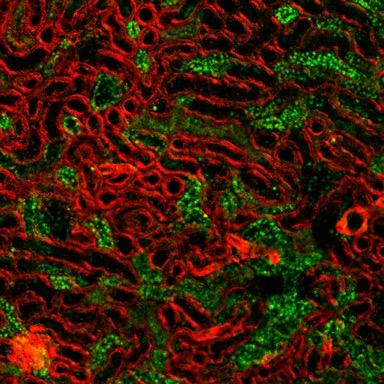![Renal tissue from laser scanning confocal microscopy, with coloration of the cytoskeleton (red fluorescence) and acetylated proteins (green fluorescence). [Egor Plotnikov]](https://genengnews.com/wp-content/uploads/2018/08/135586_web1494215592-1.jpg)
Renal tissue from laser scanning confocal microscopy, with coloration of the cytoskeleton (red fluorescence) and acetylated proteins (green fluorescence). [Egor Plotnikov]
With a large percentage of the world’s population heading toward advanced age, more people are at risk of developing complications associated with kidney disease than ever before. Now, a team of researchers from Lomonosov Moscow State University has just published findings that may provide a new approach to preventing kidney injury after ischemia. Additionally, the investigators explained why these mechanisms become nonprotective in the kidneys of an older organism. Results from the new study, which were published today in Scientific Reports in an article entitled “The Age-Associated Loss of Ischemic Preconditioning in the Kidney Is Accompanied by Mitochondrial Dysfunction, Increased Protein Acetylation and Decreased Autophagy” are focused on elucidating the mechanisms underlying severe pathologies such as renal failure caused by ischemia.
“We've shown that it's possible to prevent kidney damage by its preliminary 'training' with short periods of ischemia (blocking of blood supply),” explained senior study investigator Egor Plotnikov, Ph.D., professor within the A.N. Belozersky Institute of Physico-Chemical Biology at Lomonosov Moscow State University. “However, our main discovery is the fact that this mechanism is disabled in old animals and, as a result, a kidney becomes unprotected. It is an extremely important problem as the major part of clinical cases of renal failure occurs in aged patients. To afford the protection of their kidneys would be a great success for medicine.”
In the current study, the Russian scientists developed assays that compared data from young and old rats. While old rats are typically not easy to obtain, the Institute of Cytology and Genetics in Novosibirsk provided the researchers with a unique strain of prematurely aged rats called OXYS, for which the molecular mechanisms have been previously characterized.
“In the current article, we describe what underlies such a loss of adaptation in the kidney in old rats (and, probably, in old people),” noted Dr. Plotnikov. “All cells acquire a mechanism of 'quality control', which provides removal of damaged cellular elements (in our case—damaged mitochondria) responsible for permanent self-renewal of the system. However, these mechanisms become broken in an old kidney, and its adaptive mechanisms stop functioning.”
The scientists revealed that a considerable number of mitochondria in older rats had a lower transmembrane potential—inevitably leading to cell death. Since kidney cells cannot proliferate, their death becomes irreplaceable, leading to increasing symptoms of renal injury. This scenario leads to the kidneys being unable to fulfill their main function of removing products of metabolism from the organism, many of which are quite toxic. The researchers suggest that's why such “bad” mitochondria should be removed in the process of quality control.
In a young kidney, quality control depends on the transmembrane potential of mitochondria. When the potential drops below the critical value for a long time, a mitochondrion gets a “black label” in the form of a special protein—PINK-1. Such a labeled mitochondrion undergoes a process of self-destruction (autophagy) and is destroyed within the cellular organelles called lysosomes. In cells of old kidneys, this process is not only broken, with low-potential damaged mitochondria not being destroyed—they actually increase in number.
“We've shown that training (preconditioning) doesn't work in old age because 'bad mitochondria' aren't removed by autophagy,” Dr. Plotnikov stated. “There is the following process: we block blood supply of the kidney (namely, we deprive it of oxygen and substrates), and under these conditions, the weakest mitochondria in cells lose their potential and are immediately removed by the quality control system. As a result, the 'renewal', or just 'purges', of the mitochondrion population takes place, and only the healthy ones survive. That's why in the case of severe kidney ischemia mitochondria can cope with the damage and they survive. And what happens in old rats? We do kidney preconditioning, mitochondria lose their potential, but they aren't removed as the clean-up system operates poorly. As a result of such training, 'bad' mitochondria are only accumulated in an old cell, and in the case of kidney ischemia everything gets even worse.”
During their studies, the investigators found evidence suggesting that protein acetylation could serve as a biomarker for old (or possible premature old) cells. In the organ damaged by ischemia, the number of proteins to which an acetyl group is attached increases significantly. Yet, most important is the fact that the number of acetylated proteins within a kidney increases with aging.
“This project opens a prospect for renal failure treatment. Moreover, mechanisms that we discovered are quite universal, so it's obvious that they are also applicable not only to kidney ischemia but also to other renal pathologies,” Dr. Plotnikov concluded. “It's becoming clear why, on the one hand, aged people suffer from severe kidney injury so often and, on the other hand, why most modern treatment methods are helpless when used in case of old people. Our data show the trend for further development of drugs, which could help an old kidney to recover the capacity to resist ischemia and increase its adaptation reserves.”







